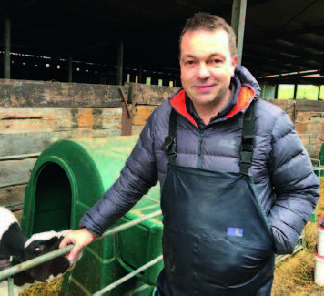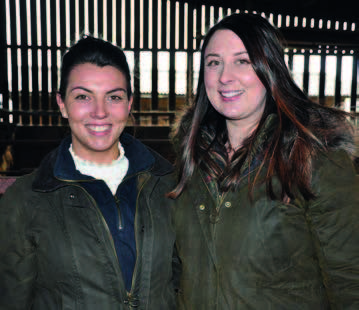Calf rearers across Wynnstay’s trading area now have an improved understanding of the important nutrition, health and hygiene practices so necessary for calves to hit optimum development and growth targets.
Thanks to a series of interactive workshops held earlier this year – organised by the Wynnstay Calf & Youngstock Team which involved a mix of classroom-based discussion and practical on-farm demonstrations – attending farmers left better equipped to improve their dairy calf rearing operations and realise the full performance potential of youngstock entering the adult milking herd.
“Whenever we get farmers together to talk about calf rearing, there is always an appetite for information exchange. Everybody participated enthusiastically and I’m sure they all went away eager to make at least one change at home,” says Jessica Yeomans from Wynnstay.
The importance of colostrum
A member of the Wynnstay team opened each workshop by highlighting the crucial importance of ensuring newborn calves receive an adequate intake of good quality colostrum, either via a teat or by stomach tubing.
“Timing is everything. As soon as a dairy calf is born, whenever possible, try to harvest the colostrum quickly from the dam so that it can be fed to the newborn calf. This is where many farms struggle. Once you have obtained the colostrum, test its quality using a refractometer or colostrometer to ensure it is good enough to feed to the calf. If it’s not, draw on your stored colostrum that does make the quality grade,” says Jessica.


Wynnstay calf specialist Jessica Yeomans explains how to use a simple weigh tape to measure calf growth rates.


When it comes to managing the impact of disease, vet Mark Hickinson says that vaccination programmes, good hygiene and husbandry will often tip the health balance in a calf’s favour.
The quantity of colostrum fed is also vital, and the aim should always be to make sure a newborn calf receives at least 10% of its birth weight in colostrum within the first few hours of life.
“Calves are born without the antibodies that are essential to prevent disease and colostrum is the sole source of these antibodies. Calves need a first feed of three litres within two hours of birth, followed by another similar sized feed within 6-12 hours of birth,” she says.
Asking your vet to blood test calves within a week of birth can also help to indicate whether they have received adequate colostrum.
Follow the heifer roadmap
Volac representatives highlighted the company’s heifer roadmap, explaining the nutrition dairy calves require to be able to calve down at 24 months of age in a ‘fit not fat’ condition, as well as being primed to achieve their genetic milking performance potential.
“Heifers need to be growing at an average rate of 800g per day to produce their first calf at 24 months of age. Any growth setback due to inadequate nutrition or disease will impair optimum development efficiency and delay this recommended first calving age target,” says Volac’s global technical manager Ian Watson.
He stresses though that ‘not all growth is the same’, pointing out that with optimum nutrition calves will grow quickly and cost-effectively during early life, whilst also laying down important udder tissue during this period. “Milk replacer may look expensive on a per tonne basis, but the latest performance-formulated products based on high-quality ingredients will payback handsomely if you feed your growing calves enough.”
Mr Watson explains that 750g per day of growth can only be achieved if pre-weaned calves receive at least 750g of milk powder per day, with ad-lib starter feed and freshwater always in front of them too.
“A 45kg calf needs 350g of milk powder just for maintenance (digestion, immune system function and keeping warm). Growth is only achieved when you feed a performance formulated milk replacer above this level,” he says.
“Asking your vet to carry out post-mortems and doing your own calf-side assessments – for example, using faecal sample diagnostic kits – can help you to identify the presence of some of the most common infectious scour organisms. You can then put in place an appropriate disease management plan, which may involve vaccination programmes, to mitigate the impact of any disease threats on your calf rearing operation.”
He stresses that many of the organisms that cause debilitating calf disease problems – such as viruses, bacteria like salmonella and E. coli, and parasites – will thrive in dirty calf accommodation and on soiled feed and water feeding equipment.
“Maintaining a high hygiene status is essential if you want to rear healthy calves that grow well. Good hygiene practices along with a sound colostrum feeding protocol in early life – as well as rearing environment improvements and vaccination, where appropriate, to boost a calf’s immune system – will all help to tip the balance in the animal’s favour and make a calf less likely to succumb to any disease challenge,” he says.
The importance of good hygeine practices
He stresses that many of the organisms that cause debilitating calf disease problems – such as viruses, bacteria like salmonella and E. coli, and parasites – will thrive in dirty calf accommodation and on soiled feed and water feeding equipment.


Members of Wynnstay Calf & Youngstock Team, including Millie Hendy (left) and Jessica Yeomans (right), are keen to help local cattle farmers improve their calf rearing operations.
The good, the bad and the ugly
The Wynnstay Calf & Youngstock Team work very closely with farm vet practices and at the workshops, local practitioners highlighted the key disease threats that calves face on a daily basis, as well as the poor husbandry and hygiene practices that can promote problems on any calf unit.
“We advise any farmer rearing calves to monitor growth rates and set a mortality target. Once you have done this be honest about your performance against your targets. Remember, if you don’t measure where you are, you can’t manage your business effectively,” says vet Mark Hickinson from Horizon Dairy Vets, who attended one of the events held in Shropshire.
“Maintaining a high hygiene status is essential if you want to rear healthy calves that grow well. Good hygiene practices along with a sound colostrum feeding protocol in early life – as well as rearing environment improvements and vaccination, where appropriate, to boost a calf’s immune system – will all help to tip the balance in the animal’s favour and make a calf less likely to succumb to any disease challenge,” he says.











